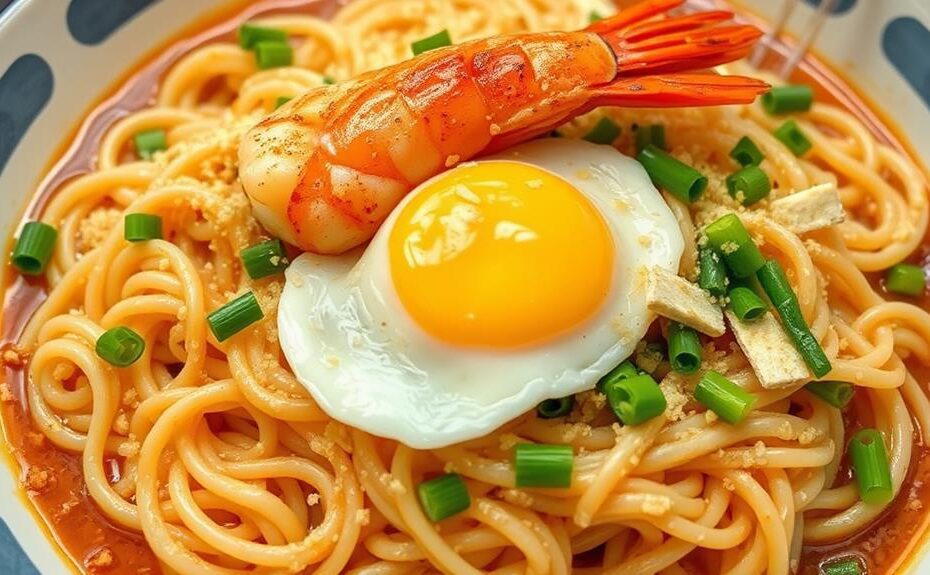Palabok noodles are a staple in Filipino cuisine, combining the convenience of Chinese noodles with the rich flavors of Spanish and Filipino cuisines. This beloved dish is a culinary tradition deeply rooted in Filipino culture, often served at family gatherings and celebrations.
The vibrant yellow-orange color of Palabok noodles comes from annatto, adding to its visual appeal. The bihon noodles' ability to absorb the savory sauce makes each bite a delight. This adaptability to regional tastes contributes to its widespread popularity.
Palabok noodles have a rich history, with influences from Chinese, Spanish, and Filipino cuisines. This cultural significance is evident in its pervasiveness at family gatherings and celebrations, bringing people together through a shared love of food.
Palabok Noodles: A Filipino Staple
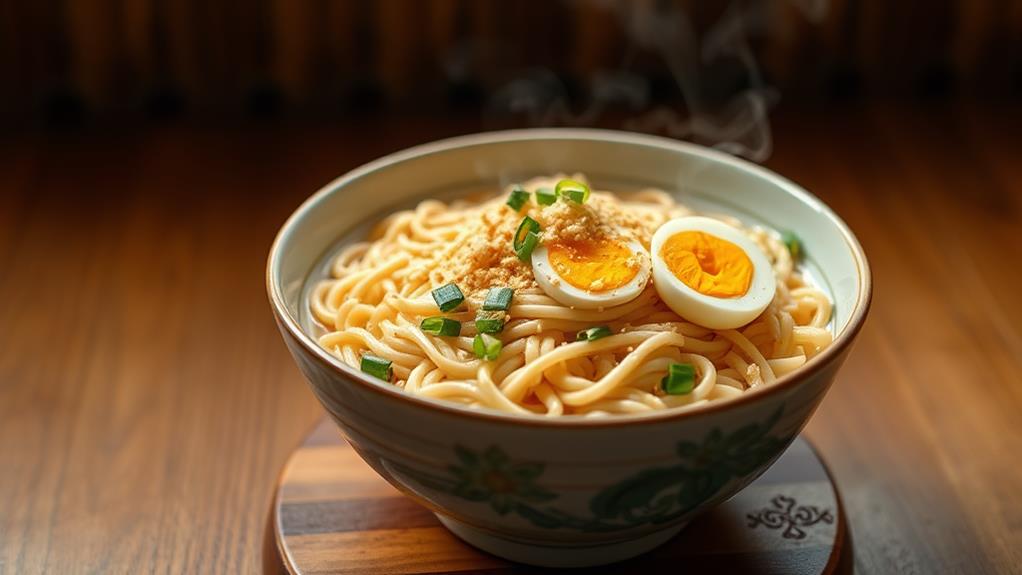
Palabok Noodles: A Filipino Staple
In the Philippines, Pancit Palabok is a beloved dish served during special occasions, and its star component is palabok noodles.
These noodles have unique properties that make them special. Palabok noodles, specifically bihon, are thin rice noodles that absorb the rich shrimp and pork sauce perfectly.
Before combining them with the sauce, they're traditionally soaked in hot water to achieve a perfect texture.
This Filipino dish is often served during special occasions, symbolizing hospitality and family bonding.
The vibrant yellow-orange color, derived from annatto, adds to the visual appeal of the bihon noodles, making it a favorite for festive gatherings.
As a staple in Filipino cuisine, palabok noodles provide carbohydrates and protein, contributing to the overall sustenance of the dish.
Origins of Pancit Palabok
The Origins of Pancit Palabok
Pancit Palabok, a beloved Filipino dish, has its roots in Chinese noodle traditions. The term "Pancit" means "conveniently cooked dish" in Hokkien, a Chinese dialect. Introduced by Chinese migrants, this dish has evolved over time, blending Chinese and Spanish influences with Filipino cuisine.
Cultural Influences
The unique flavor profile of Pancit Palabok is a result of the blending of different cultural influences. The Chinese influence is evident in the use of rice noodles (bihon) and annatto powder.
The Spanish influence is seen in the rich sauce made from shrimp and pork.
Filipino adaptation of ingredients and cooking techniques has also played a significant role in shaping the dish.
Significance in Filipino Culture
Traditionally served during special occasions, Pancit Palabok symbolizes hospitality and family bonding in Filipino culture.
Over time, the dish has evolved, with regional adaptations like Pancit Luglug and Pancit Malabon showcasing diverse ingredients and preparation styles.
This beloved national dish highlights the Philippines' multicultural heritage, where flavors and cooking techniques from different cultures have fused together.
The Signature Palabok Sauce
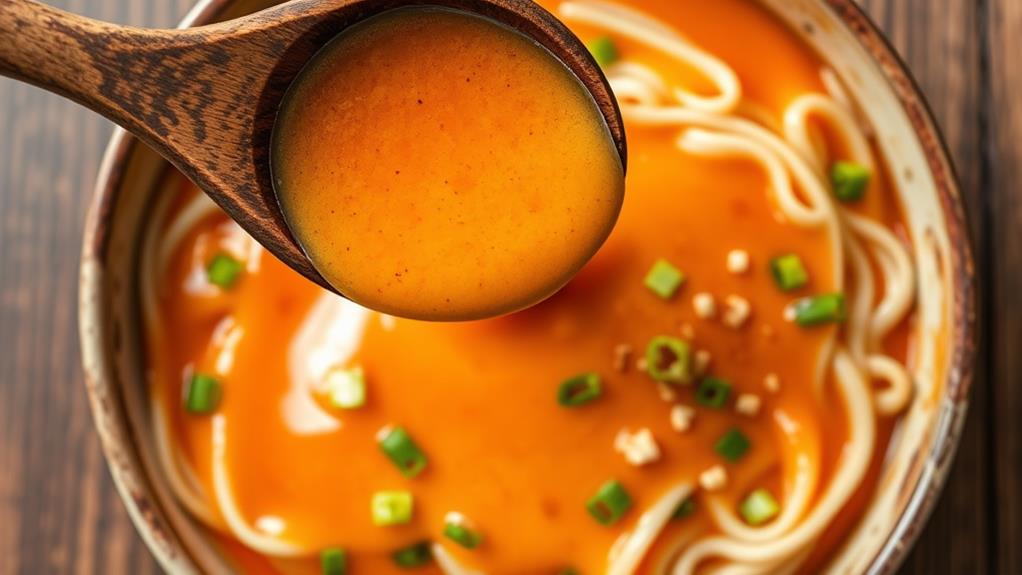
The Signature Palabok Sauce
The signature Palabok sauce is a crucial element that sets this beloved Filipino dish apart from other noodle dishes. This rich, savory seafood-flavored sauce is a masterful blend of shrimp stock and ground pork, adding depth and complexity to the dish's flavor profile.
The sauce gets its distinctive yellow-orange color from annatto powder.
To achieve the perfect consistency, a cornstarch slurry is added to thicken the sauce, ensuring it clings to the noodles in every bite. Fish sauce, or patis, is often incorporated to amplify the umami flavor, further enhancing the overall taste experience.
The fragrant base of sautéed garlic, onions, and simmered shrimp stock is essential for achieving the authentic flavor of Pancit Palabok sauce. This flavorful base allows the sauce to stand out as a key component of what makes Palabok Noodles a Filipino favorite.
Ingredients and Preparation Methods
Understanding Ingredients and Preparation Methods
Traditional Ingredients: Pancit Palabok is made with thin rice noodles called bihon, which absorb the rich flavors of the sauce. The sauce is prepared using a base of shrimp stock and pork broth, enhanced with annatto for color and flavor.
Key ingredients include sautéed garlic and onions, ground pork, and a combination of fish sauce for seasoning.
Preparation Methods: To prepare the noodles, soak them in hot water until softened, rather than boiling them, to maintain their texture.
Then, combine the noodles with the flavorful sauce and top them with garnishes like hard-boiled eggs, chicharrón, and smoked fish, adding extra flavor and texture.
Variations of Pancit Palabok
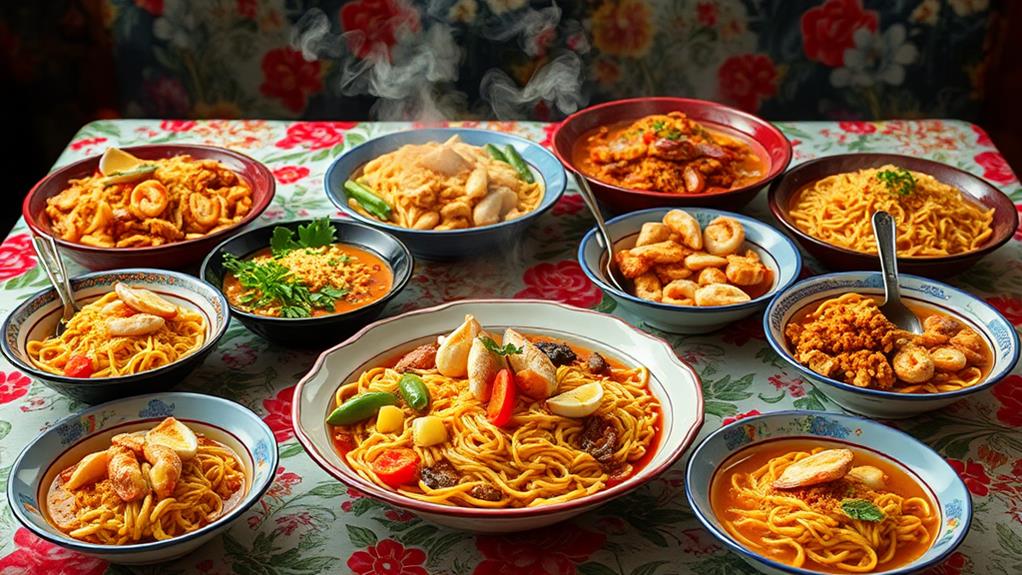
Regional Variations of Pancit Palabok
Pancit Palabok has evolved into diverse noodle dishes, each with its own unique characteristics.
Variations in Noodle Types and Ingredients
The regional twists on Pancit Palabok differ in noodle types, ingredients, and preparation methods. For instance:
| Variation | Noodle Type | Characteristics |
|---|---|---|
| Pancit Luglug | Thicker cornstarch noodles | Different texture and mouthfeel |
| Pancit Malabon | Thick, tubular rice noodles | Greater variety of seafood, distinct composition |
| Pancit Canton | Wheat noodles | Stir-fried with assorted proteins and vegetables |
| Pancit Palabok | Thin rice noodles (bihon) | Rich shrimp and pork sauce, absorbent noodles |
Cultural Significance and Adaptability
Each regional variation of Pancit showcases unique preparation methods and ingredient choices, highlighting the adaptability and cultural significance of noodle dishes across the Philippines. These variations offer a distinct flavor profile and texture, allowing you to experience the diversity of Filipino cuisine.
Nutritional Value and Cooking Tips
Pancit Palabok's Nutritional Profile
Pancit Palabok is a nutrient-rich dish that provides a good source of energy. It contains 74g of carbohydrates per serving, making it an ideal option for those seeking a quick energy boost. Additionally, it is a decent protein provider, with 32g primarily coming from shrimp and pork, which supports muscle repair and overall health.
Moderating Fat Content
While Pancit Palabok offers several nutritional benefits, it's essential to be mindful of its moderate fat content of 14g, including 4g of saturated fat. To adjust this, choose leaner meats or alternative proteins, such as chicken or tofu, to reduce the fat content.
Optimizing Nutritional Value through Cooking Methods
Using shrimp stock instead of bouillon cubes can enhance the flavor of Pancit Palabok while reducing sodium content.
The dish is also rich in essential vitamins and minerals, including Vitamin A, Calcium, and Iron, which are present in garnishes like green onions and eggs.
Cultural Significance and Traditions
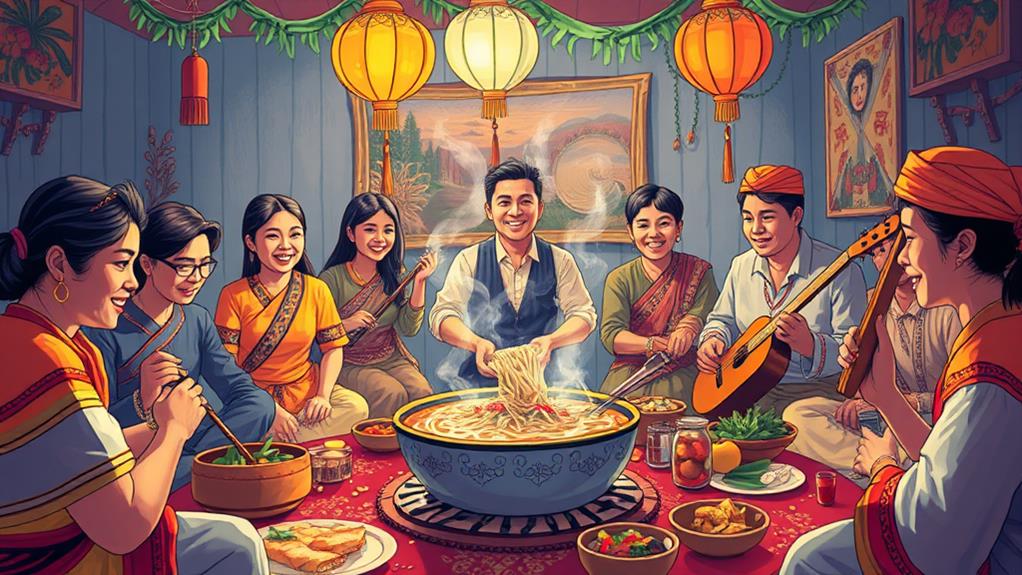
Pancit Palabok: A Symbol of Filipino Hospitality and Familial Bonding
In the Philippines, Pancit Palabok is a staple dish served during special occasions, including birthdays, weddings, and holidays, emphasizing the importance of family and friendship. This tradition is deeply rooted in Filipino culture, reflecting the country's values of hospitality and community.
When Filipinos gather to celebrate, they share Pancit Palabok communally, often using their hands to foster a sense of connection. This comfort food evokes nostalgia and a sense of belonging among Filipinos, both in the Philippines and abroad.
The dish's vibrant colors and rich flavors represent Filipino culinary heritage, blending various cultural influences.
Pancit Palabok's cultural significance extends beyond its taste, as it brings people together and strengthens family bonds. By serving this dish during celebrations, Filipinos demonstrate their commitment to community and hospitality.
Regional Influences and Adaptations
Regional Influences Shape Pancit Palabok's Flavor Profile and Presentation
The diverse regional influences in the Philippines have significantly impacted the flavor profile and presentation of Pancit Palabok.
Each region has its own twist on the dish, reflecting local tastes and traditions. For example, Pancit Luglug features thicker cornstarch noodles, while Pancit Malabon boasts seafood-heavy sauces and tubular rice noodles.
Local Ingredients Vary by Region
The use of local ingredients also differs by region.
Coastal areas incorporate more seafood, such as shrimp and squid, while inland regions focus on pork and chicken.
Even garnishes vary, with some areas adding tofu, eggs, or annatto seeds for added flavor and texture.
Cultural Celebrations and Local Festivals Influence Preparation and Service
Cultural celebrations and local festivals also influence how Pancit Palabok is prepared and served.
Each region puts its own spin on the dish to celebrate community and heritage.
This has resulted in a rich tapestry of Pancit Palabok variations, making each bite a unique experience that showcases the country's diversity.
What Is the Difference Between Palabok Noodles and Pancit Rice Noodles in Filipino Cuisine?
Palabok noodles are thick rice noodles typically used in Filipino cuisine, while Filipino pancit rice noodles are thin rice noodles. Palabok noodles are often used in dishes like Pancit Palabok, a traditional Filipino noodle dish with a savory shrimp sauce, while pancit rice noodles are used in various Filipino noodle stir-fry dishes.
Evolution and Innovation in Pancit Palabok
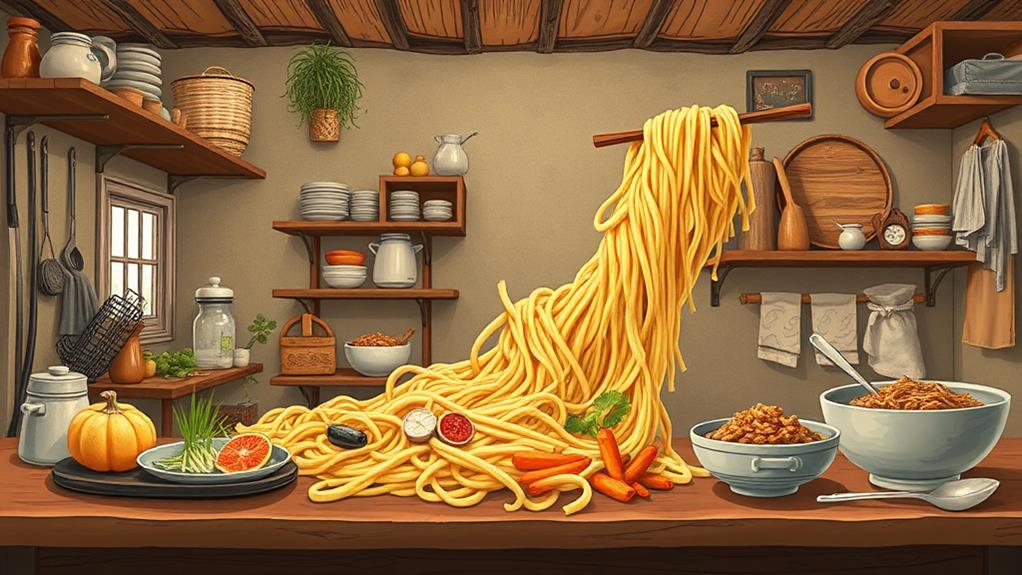
Pancit Palabok's Evolution
Pancit Palabok has undergone significant transformations over time, adapting to diverse tastes and preferences while maintaining its traditional roots.
Innovations in Ingredients
Traditional recipes now incorporate fresh ingredients, such as shrimp stock and annatto, for added flavor and color.
These modern twists enhance the dish's overall appeal.
Streamlined Preparation
Innovations in preparation methods, like using shrimp bouillon cubes or pre-packaged sauces, make it easier to recreate this dish with less time and effort.
These shortcuts simplify the cooking process without compromising flavor.
Regional Variations
Variations of Pancit Palabok have emerged, featuring different types of noodles, such as bihon or thicker cornstarch noodles, to accommodate regional preferences and available ingredients.
This adaptability showcases the dish's versatility.
Customizable and Versatile
The customizable nature of Pancit Palabok allows for personalizations with various toppings, including seafood, tofu, or vegetables, showcasing the dish's appeal across different dietary preferences.
This flexibility ensures that Pancit Palabok remains a staple of Filipino cuisine.
Enduring Legacy
Today, Pancit Palabok continues to blend Chinese noodle traditions with Spanish and local flavors, capturing the hearts and taste buds of many.
Its rich history and adaptability ensure its enduring popularity.
Frequently Asked Questions
Is Palabok Originated in Philippines?
Yes, Palabok originated in the Philippines.
This popular dish emerged as a fusion of Chinese and Spanish culinary influences in the Philippines.
The name "Pancit," which refers to a category of Filipino noodle dishes including Palabok, comes from the Hokkien word "pian e sit," meaning "conveniently cooked dish."
This historical significance reflects the cultural exchange and blending of traditions that occurred in the Philippines.
What Is the English Term for Palabok?
Palabok is often referred to as "Pancit Palabok" in English. This name specifically describes the rice noodle dish with a savory shrimp and pork broth sauce, highlighting the unique flavors and traditions of the Philippines.
Palabok itself doesn't have a direct English translation because it's a distinct Filipino dish with a rich history and cultural significance.
What Kind of Noodles Do Filipinos Eat?
Filipinos eat a variety of noodle types, including rice noodles, wheat noodles, and egg noodles. These noodles can be fresh or dried and are used in different noodle dishes.
Stir-frying and soups are common noodle preparation methods, often topped with ingredients like vegetables, meat, or seafood.
Two examples of popular Filipino noodle dishes are Pancit Canton and Sotanghon Guisado. These dishes reflect the country's rich cultural influences, which have shaped the diverse types of noodles and cooking methods used.
How Does Palabok Taste?
The flavor profile of palabok is rich and savory with a deep umami taste. This is due to the combination of ingredients used in the dish.
The shrimp-infused toppings add a burst of flavor, while the garlic oil and crispy chicharrón provide a satisfying crunch.
Additionally, hard-boiled eggs add creaminess, which complements the noodle texture.
